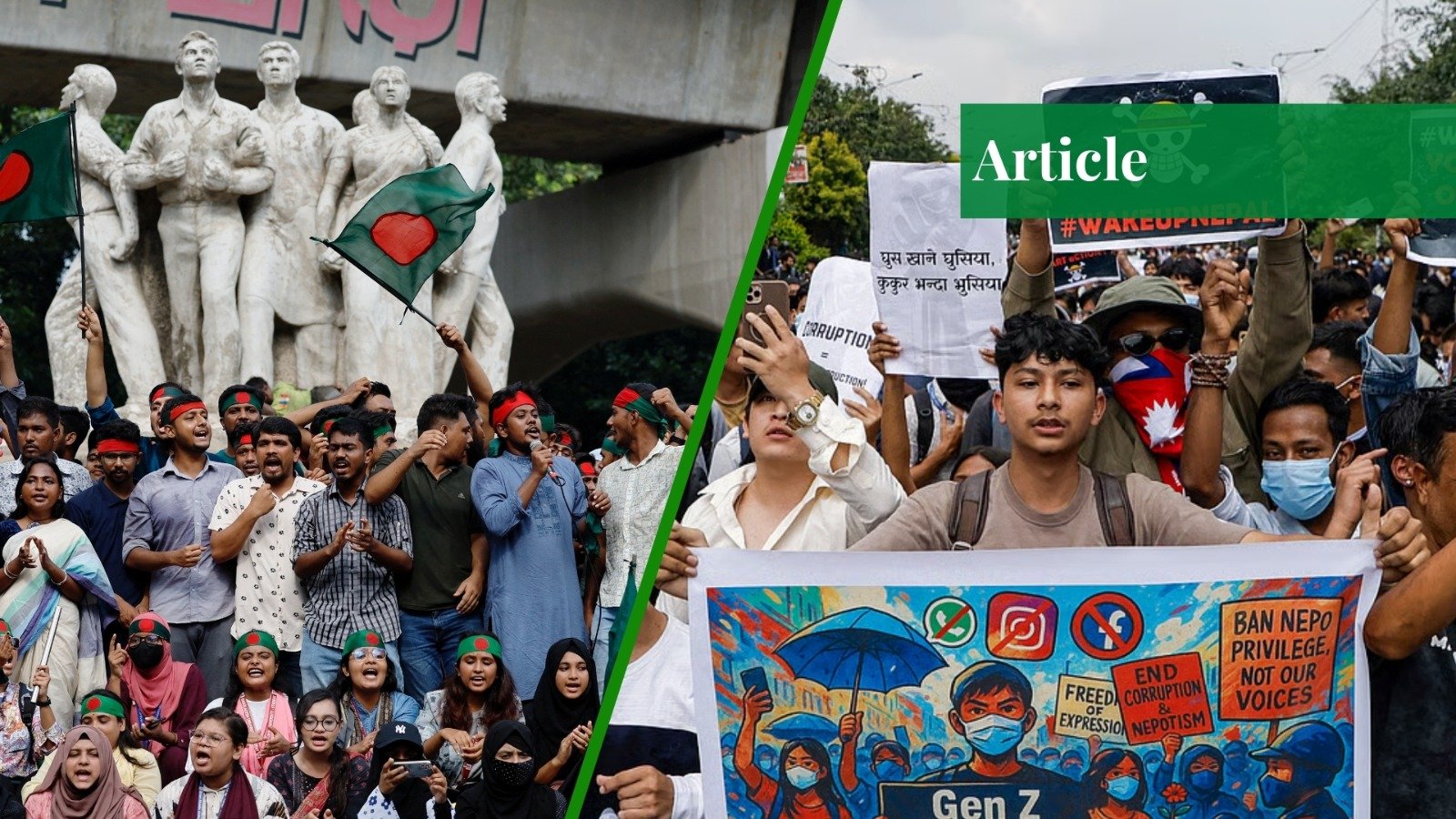Independence anniversaries have an established choreography in South Asia: flags raised at dawn, official speeches recalling history, songs, and chants raised in celebration of freedom. However, something strange lurks below the surface. If we were to accept that independence is the pursuit of justice and regeneration, then why do we continue to see structural injustices of the last few decades so apparent, widespread, and becoming increasingly brutal? That question is surfacing in Nepal and Bangladesh, where young people, frustrated with corruption, nepotism, and elite impunity, are undertaking historic mobilizations that have ousted leaders, changed governments, and disrupted the political status quo.
For Pakistan, observing these surges of discontent goes beyond curiosity. They serve as a mirror. Given that Pakistan’s largest demographic is comprised of the youth, it also raises the question: could Pakistan’s youth spark a fresh wave of reforms? More importantly, what will reforms look like, and in what conditions will they come to fruition?
The point is not to romanticize street rebellions. Revolutions, after all, can implode, and the haze from burning tires rarely settles into durable democratic institutions. However, these moments offer potent evidence: the potential of demographics.
Nepal and Bangladesh: Signals of a Regional Pattern
The recent protests in Nepal, driven by Gen Z, began with a single policy, a ban on social media platforms, which would seem like a trivial issue. However, amidst ongoing corruption and excessive consumption by ruling elites, this policy turned out to be the spark to dry grass. Hundreds of students, young professionals, and citizens flooded the streets and demanded not only the removal of censorship but also accountability from the elite. For Prime Minister Oli, his resignation was no longer a resignation. This was a total rejection of the entitlement culture of privilege that might appease the old and the comfortable, while impoverishing and exploiting the young and vulnerable.
Bangladesh‘s revolution began with a different trigger, an argument over quotas in public service positions. But, something very small and technical, transformed into mass resistance against the authority and corruption. Leaders resigning, leaders leaving behind interim administrations; this was no longer just about quotas. It was about a generation refusing to inherit silence and complicity. What started within student unions ended up giving shock to the state apparatus, even making leaders and political parties obsolete.
The similarities are striking. Both movements began with localized complaints, escalated into systemic critiques, as well as action by large swaths of young people whose frustrations had long gone ignored and unaddressed. Both confronted regimes that initially underestimated the depth of anger and deployed repression. And both underline a larger regional truth: South Asian democracies are not just fragile, they are brittle in the face of youth whose lives have more to do with precarity than promise.
Pakistan’s Demographic Question
Pakistan contains one of the largest youth populations in the world. The Pakistan Bureau of Statistics (2024) indicates that almost 63.9% of people in Pakistan are below age 30; and the finance government reports that around 26% of Pakistanis fall into the 15 to 29 age cohort, which is referred to as the cohort most tied to political mobilization and activism. However, this “youth bulge” is leading more towards frustration than to reformist energy.
The reasons are clear. Youth unemployment remains extraordinarily high. The Global Economy 2024 found that the unemployment rate among educated youth is over 9.86%, especially among university graduates who enter a saturated job market. Each year, millions of new graduates emerge in a country that cannot sustain them. Many of these graduates either emigrate out of Pakistan, over 750,000 Pakistanis emigrated for job purposes in 2022, many allow themselves to become trapped in insecure or low-paid jobs. Various sources of patronage politics and corruption, the lack of merit in hiring, and the presence of nepotism contribute to a generational sense of betrayal.
Simultaneously, state institutions have become increasingly repressive toward dissent, closing down legitimate spaces for expression. Pakistan sits at 152 out of 180 on the Reporters Without Borders World Press Freedom Index (2024), and digital tools of monitoring, including shutdowns of the internet during protests, site bans, and monitoring, create a climate of fear online.
Still, youth have not mobilized in the same way as their counterparts in Nepal or Bangladesh. Youth have shown flashes of resistance: during the Lawyers’ Movement in 2007, which took on General Musharraf’s dismissal of the chief justice, youth were present in numbers; attempts to reassert student collectives like the Progressive Students Federation; students have attempted to organize through digital campaigns on issues like climate justice, women’s rights, and corruption, which all point to a lack, or failure, of governance; the Aurat March has become a visible mobilization with ongoing campaigns; this shows the capacity for grassroots digital mobilization.
However, there has not been a single spark that has developed into a generational uprising. Why? Part of the answer has to do with the actual structural restrictions and the ways that power is distributed. Unlike Nepal, where social media became the point of mobilization, Pakistan has invested in a stronger censorship apparatus. On a daily basis, the Pakistan Telecommunication Authority (PTA) throttles Twitter/X, bans TikTok, and applies the Prevention of Electronic Crimes Act (PECA) to arrest dissenters.
Unlike our immediate neighbor, Bangladesh, in which student unions still serve as tools for mobilization, Pakistan has dismantled formal student union structures since the 1980s under Zia-ul-Haq’s dictatorship. Although there have been incremental attempts at reviving student unions, student unions are still restricted from formal legal recognition, which in turn renders students politically marginalized.
Structural Barriers to Mobilization
Censorship is the first crucial obstacle. A youth movement today needs coordination, methods to organize, narrate, and inspire. When Nepal tried to shut down social media, it backfired because young people organized and amplified their dissatisfaction through social media, it became a part of the rallying cry.
Pakistan, by contrast, has social media platforms that are already heavily surveilled and occasionally turned off. The organizers are aware they’re being surveilled, tweets disappear, accounts get shut down, and PECA is routinely weaponized to threaten dissenters with imprisonment. Even world-renowned personalities, journalists, academics, and human rights activists are harassed, incarcerated, or constitute years of trials.
This creates a chilling effect: not only are voices silenced, but people willing to participate silence themselves in fear of retribution. Additionally, online disinformation campaigns originate, framing dissenters as “foreign agents” or “anti-state,” and break down the trust that is key to consolidating movements.
The second obstacle is patronage politics. In Pakistan, opportunities are not based on merit. Kinship connections, feudalism, and political loyalty mediate access to jobs and promotions, educational scholarships, and health care. Patronage politics produces a culture of dependence in which directly challenging the system seems impossible, and often dangerous. If employment or access to state resources are dependent on patronage, the direct material risk of resisting the elite is exclusion, blacklisting, ruin, etc.
Unlike Nepal, where student and civil society groups historically developed an independent space, Pakistan’s political economy actively co-opts potential resistance. Patronage co-opts dissent by offering small favors, a contract here, a transfer order there, whilst leaving the underlying conditions of inequality unchanged. To maintain the status quo, the system is not crushing dissent outright; it is fragmenting it, co-opting it, and buying it off.
Reform vs. Street Upheaval
This is the crux of the matter: for Pakistan, the question is not whether its youth might rise in the future. The question is whether that rise could, in principle, be productive and channeled to renew democracy as opposed to chaos. Revolts can be disruptive, but do not guarantee reform. History is full of rebellions that created upheaval, overthrew leaders, and reverted to the same injustices but under different elites.
Reform, however, requires the presence of institutions that can contain and convert grievances into policy and institutionalize change that is not limited to any one term. In Nepal and Bangladesh, the institutions bowed, but the outputs are still uncertain; we still don’t know whether this will cause systematic redistribution of power away from elites or not.
True reform means anticipating grievances before they become explosions; restoring student unions so that anger has a legitimate outlet, defending digital rights so that dissent does not have to act in the dark, dismantling patronage systems that the prison movement has, and defining real pathways of employment and merit-based systems. It means conceptualizing youth as a constituency to be represented rather than a population to be contained. Without this pivot, Pakistan will learn too late the lesson of Nepal and Bangladesh: when reform is systematically denied, then agitation and upheaval can no longer be contained, and that can be disastrous with no solid conclusion.
Conclusion: Asking the Hard Question
The ultimate threat in Pakistan is not that its youth will rebel; it’s that they will disengage. Apathy is just as corrosive as protest. When young people feel that their voice matters little, they choose to retreat and become passive survivalists through migration, disengagement, or quiet anger. Such disengagement eats away from the inside and leaves little room for any healthy form of democracy. Will Pakistan continue leaning into censorship and benefitting the interests of elites? Or will it instead take the risk of engaging the voices of youth, while it lets in the discomfort of their criticism?
The upheavals in Nepal and Bangladesh are not abstract events. They are warnings in the language of demographics and dignity. The youth of Pakistan is watching and waiting. For the state, the choice is straightforward: reform while you can. That choice is the real question of whether independence means something other than ritual, and whether democracy can be rejuvenated in time.
If you want to submit your articles and/or research papers, please visit the Submissions page.
To stay updated with the latest jobs, CSS news, internships, scholarships, and current affairs articles, join our Community Forum!
The views and opinions expressed in this article/paper are the author’s own and do not necessarily reflect the editorial position of Paradigm Shift.
Momina Areej is currently pursuing an MPhil in Clinical Pharmacy Practice. With a passion for writing, she covers diverse topics including world issues, literature reviews, and poetry, bringing insightful perspectives to each subject. Her writing blends critical analysis with creative expression, reflecting her broad interests and academic background.



